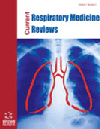- Home
- A-Z Publications
- Current Respiratory Medicine Reviews
- Previous Issues
- Volume 15, Issue 3, 2019
Current Respiratory Medicine Reviews - Volume 15, Issue 3, 2019
Volume 15, Issue 3, 2019
-
-
Upper and Lower Airways Diseases in Childhood
More LessAuthors: Giuseppe F. Parisi and Salvatore LeonardiIn the last decade, extensive research has provided consistent advances in molecular biology and “omics” science (genomics, metabolomics, proteomics, and transcriptomics), which have led to the detailed characterization of the etiology, pathophysiological mechanisms, and subtypes of many diseases. Based on these developments, the concept of precision medicine was established. About a quarter of medical consultati Read More
-
-
-
Biomarkers in Pediatric Lung Diseases Including Cystic Fibrosis
More LessIn recent decades, scientific studies of chemical processes involving metabolites have been steadily increasing, indicating that we are well into the metabolomics era. This has resulted in numerous studies that explore the field of biomarkers. One of the medical areas most concerned with these innovations is certainly that of childhood respiratory disorders, including asthma and cystic fibrosis. This current study is a review of the l Read More
-
-
-
Cystic Fibrosis: New Insights into Therapeutic Approaches
More LessAuthors: Antonella Tosco, Valeria R. Villella, Valeria Raia, Guido Kroemer and Luigi MaiuriSince the identification of Cystic Fibrosis (CF) as a disease in 1938 until 2012, only therapies to treat symptoms rather than etiological therapies have been used to treat the disease. Over the last few years, new technologies have been developed, and gene editing strategies are now moving toward a one-time cure. This review will summarize recent advances in etiological therapies that target the basic defect in the CF Trans Read More
-
-
-
Towards Precision Medicine in Pediatric Severe Asthma: An Update on Current and Emerging Biomarkers
More LessPediatric severe asthma is actually considered a rare disease with a heterogeneous nature. Recent cohort studies focusing on children with severe asthma identified different clinical presentations (phenotypes) and underlying pathophysiological mechanisms (endotypes). Phenotyping and endotyping asthma represent the current approach to patients with severe asthma and consist in characterizing objectively measurable Read More
-
-
-
Novel Biologics for the Treatment of Pediatric Severe Asthma
More LessEstimated to represent less than 5% of all asthmatic patients, children with severe asthma experience troublesome persistent symptoms, life-threatening attacks and side effects by oral corticosteroid treatment, that significantly impact on the quality of life and on economic costs. An accurate understanding of the mechanisms of the disease has been crucial for the discovery and development of biological therapies, f Read More
-
-
-
An Overview of HMGB1 and its Potential Role as a Biomarker for RSV Infection
More LessAuthors: Sara Manti, Caterina Cuppari, Giuseppe F. Parisi and Carmelo SalpietroRespiratory Syncytial Virus (RSV), an enveloped, non-segmented, negative-sense RNA virus of the Paramyxoviridae family, is the most common respiratory pathogen in infants and young children worldwide, also leading to lower respiratory tract infections during infancy and subsequent development of recurrent wheezing and asthma in childhood. Despite many years of research, we still lack reliable biomarkers of the dis Read More
-
-
-
Genetic Disorders of Surfactant Deficiency and Neonatal Lung Disease
More LessAuthors: Maria Papale, Giuseppe F. Parisi, Amelia Licari, Raffaella Nenna and Salvatore LeonardiPulmonary surfactant is a heterogeneous combination of lipids and proteins, which prevents alveolar collapse at the end of expiration cycle by decreasing the alveolar surface tension at the air-liquid interface. At birth, the expression of surfactant is very important for normal lung function and it is strictly correlated to gestational age. The best known genetic mutations associated with the onset of respiratory distress in pret Read More
-
-
-
Genetic Anomalies of the Respiratory Tract
More LessHereditary lung diseases can affect the airways, parenchyma and vasculature of the lung. Such diseases comprehend simple monogenic disorders such as Kartagener syndrome and α1-antitrypsin deficiency, in which mutations of critical genes are sufficient to induce well128;defined disease phenotypes. A major comprehension of the genetic basis of pulmonary diseases has produced new investigations into their underlying p Read More
-
-
-
Adenoidal Immune Response in the Context of Inflammation and Allergy
More LessThe mucosal-associated lymphoid tissues of the upper respiratory tract, including adenoids and palatine tonsils, are considered as the first line of defense against respiratory infections, being important effector organs in both mucosal-type and systemic-type adaptive immunity. They are strategically located for mediating both local and regional immune functions, as they are exposed to antigens from both the inhaled air ( Read More
-
-
-
The Immunomodulatory Role of Vitamin D in Respiratory Diseases
More LessThe growing interest in the new role of vitamin D, particularly as an immunomodulatory factor, has spurred basic research and the development of clinical trials to better understand the influence of supplementation on various diseases. Vitamin D is an important nutrient factor in human health due to its role in calcium metabolism regulation, cellular growth, differentiation and its fundamental discovered activity in immune functi Read More
-
Volumes & issues
-
Volume 21 (2025)
-
Volume 20 (2024)
-
Volume 19 (2023)
-
Volume 18 (2022)
-
Volume 17 (2021)
-
Volume 16 (2020)
-
Volume 15 (2019)
-
Volume 14 (2018)
-
Volume 13 (2017)
-
Volume 12 (2016)
-
Volume 11 (2015)
-
Volume 10 (2014)
-
Volume 9 (2013)
-
Volume 8 (2012)
-
Volume 7 (2011)
-
Volume 6 (2010)
-
Volume 5 (2009)
-
Volume 4 (2008)
-
Volume 3 (2007)
-
Volume 2 (2006)
-
Volume 1 (2005)
Most Read This Month
Article
content/journals/crmr
Journal
10
5
false
en


